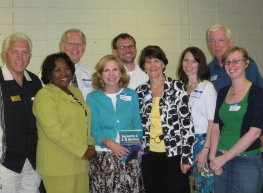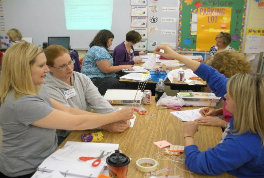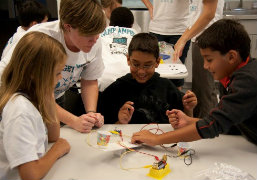How to Develop a Top-Notch STEM Program
A MiddleWeb Blog
 This week I’d like you to meet top-notch STEM program developer Dr. Susan Pruet. I was fortunate enough to work with Susan as she developed and directed two remarkably successful NSF-funded school reform efforts involving STEM education: the Maysville/Mobile Math Initiative and, more recently, the middle grades program Engaging Youth through Engineering.
This week I’d like you to meet top-notch STEM program developer Dr. Susan Pruet. I was fortunate enough to work with Susan as she developed and directed two remarkably successful NSF-funded school reform efforts involving STEM education: the Maysville/Mobile Math Initiative and, more recently, the middle grades program Engaging Youth through Engineering.
Susan – best described as a high-energy dynamo – has a talent and a well-designed process for establishing successful STEM reform initiatives. And she is masterful at joining hands with teachers, administrators, and community & business leaders to make it happen.
In this guest blog post, Susan passes along some of her wisdom on how to design and implement a successful, sustainable STEM program. Here are 7 tips Susan thinks you should know up front.
 Great STEM Learning: Seven Tips to Get You Started
Great STEM Learning: Seven Tips to Get You Started
By Susan Pruet
1. Plan, Plan, Plan!
Designing a STEM program is a huge learning curve for a school or system. In fact, as you delve into it, it can appear overwhelming. Careful planning is key here – in fact, comprehensive planning is vital to successful STEM initiatives. Consider these ideas for your planning process:
► Allot enough time. Setting aside enough time for meticulous planning is hard to do, and this part of the initiative is often short-circuited. We allotted one full year for careful, thorough planning.

Some administrators, engineers, & teachers learning & planning for STEM
► Use a team approach, even in the thinking and planning stages. Make sure you pull the right people together to figure things out. We gathered a diverse team that included teachers, administrators, business leaders, community leaders, varied ethnicities, and outside folks with knowledge and experience.
► Develop clarity around why you want to do STEM and what your STEM program needs to look like. The why depends on where your need is coming from: Your community? Your student population? The business sector? The call to raise math and science scores? Because you believe all kids should have 21st Century skills?
Our STEM program began as a K-12 workforce initiative. We designed and implemented it in response to needs of industries in the Mobile area, such as aerospace and shipbuilding. Our area industries were needing a different type of graduate – able to think critically, work in teams, and apply math and science to solve problems.
When you reach clarity on why you want to implement STEM, develop clarity around what kind of STEM program works best for the need you identified. We decided that an integrated STEM approach built around an engineering problem-solving process would best suit our students’ needs and would provide our industries with the workforce they needed.
► Plan for Sustainability. How will your STEM program be sustained over the long term? How will you get plenty of buy-in so that this isn’t a one-person show? Get some solid, grass-roots support in place before you roll out your STEM program.
Keep in mind that a simple plan is easier to sustain than a complicated one. How will it be funded and managed during implementation? Heads up! If you are doing a rollout for a large school system, it will take a full time, knowledgeable person to pull this off and facilitate it.
Put a lot of time, energy, and effort into the planning. Then, when you know the why and what, think about the how.
2. Know thyself.
Do an up-front assessment of schools and systems where you will roll this out. Do all involved know their role, and are they equipped to fill it? Are teachers motivated and prepared to implement STEM? Do they know how to work in teams with other adults, manage student teams, and work with open ended teaching approaches?
Know the community your students come from and what skills they will need – social and academic. Examine your building, schedule, supplies, and technology situation. Analyze the kind of support you will be able to provide teachers and students as they work through the rollout and implementation process.
3. Provide quality ongoing professional development and support.

4. Monitor in a meaningful way.
Plan on a 5-year period to roll out the STEM program, monitor the progress, adapt as needed, and get the initiative fully in place. Picture where you want to be 5 years from the rollout date. What changes do you expect to see in the system, schools, classrooms, and the community as a result of having this STEM initiative operating successfully? Decide how you will measure progress toward those outcomes and prepare to intervene as needed to keep things on track.
5. Communicate, communicate, communicate.
Keep everyone informed about the STEM initiative and the progress. Do this regularly and in every available medium – newspaper, social media, etc. Communicate and celebrate small initial successes. Implementing a STEM program is hard work, so take every opportunity to encourage those involved.
6. Be tenacious and persistent.
Nothing worthwhile is going to happen fast. Tackle the challenges with enthusiasm, positive outlook, ongoing effort, and determination. You are in this for the long term. Be ready for push-back and don’t get discouraged. Mechanisms in place since time began can undercut and sabotage your efforts. Even with the current national groundswell of support for STEM, it’s still hard to build a successful program. The status quo pull is strong, so build a critical mass of folks who want this to work and will stay the course.
7. Use a well-developed STEM curriculum – this is vital!

That’s just a starter-set of ideas. Remember, our country won’t survive with “education as usual.” Build a STEM program that will inspire our next generation of citizens and workers to solve problems – whether family problems or business problems – and to make the world a better place.
Susan Pruet just started her own consulting company, STEMWorks, LLC. She plans to support others interested in providing quality STEM education for all students – especially in the upper elementary and middle school grades. If you have questions, email Susan at susan.stemworks@gmail.com Find her on Twitter @susanpruet. Send her a tweet. She’s a newbie!































These are great tips for starting a STEM initiative, Susan!
Lots of good ideas here. We posted a link to your article here http://bit.ly/1jZfugW
Thanks to manufacturingstories for sharing this post. I went to your site and found a lot of great information there as well. I’m going to share the link to your site in an online course I’m teaching and in a future blog. Love good resources!